Operation Frequent Wind was the final phase in the evacuation of American civilians and “at-risk” Vietnamese from Saigon, South Vietnam prior to the takeover of the city by the North Vietnamese Army (PAVN) in the Fall of Saigon. It was carried out on 29–30 April 1975, during the last days of the Vietnam War.
Although the United States had withdrawn its combat troops in 1973, thousands of Americans remained behind, including those stationed in Saigon at the Defense Attaché Office (DAO) and the U.S. Embassy. By March 1975, North Vietnamese troops were closing in on the capital, having captured several strategic sites including Da Nang, Ban Me Thout and Song Be, and then paused for a week at the outskirts of Saigon, possibly waiting for the South Vietnamese government to collapse and avoiding a possible confrontation with the U.S. by allowing the mostly-unopposed evacuation of Americans from Saigon.

Seeing the writing on the wall, the U.S. began to evacuate its personnel and others, including Vietnamese orphans through Operation Babylift. From April 1 to April 29, 45,000 people, including over 5,000 Americans, were evacuated from the country using a variety of aircraft including commercial and military aircraft. Things took a turn for the worst, however, beginning on April 27:
On 28 April, North Vietnamese forces were close enough to launch rockets into Saigon. At 18:06, three A-37 Dragonflies piloted by former VNAF pilots, who had defected to the Vietnamese People’s Air Force at the fall of Danang, dropped six Mk81 250 lb bombs on Tan Son Nhut Air Base destroying several aircraft. VNAF F-5s took off in pursuit, but they were unable to intercept the A-37s. C-130s leaving Tan Son Nhut reported receiving North Vietnamese Army (PAVN) .51 cal. and 37 mm anti-aircraft (AAA) fire while sporadic rocket and artillery attacks also started to hit the airport and air base. The fixed-wing evacuation was terminated and Operation Frequent Wind commenced
Operation Frequent Wind
To assist with the evacuation, the Navy had moved a large number ships off of the Vung Tau Peninsula in the South China Sea. Several aircraft carriers were among the group, including the Hancock, Enterprise, Coral Sea, Okinawa and Midway.
Navy and Air Force fighters provided air support for the evacuation, which included 71 U.S. helicopters and 20 from Air America. The entire U.S. air operation was controlled through a “USAF C-130, Airborne Command and Control Center” that remained in the sky throughout the evacuation.
In advance of the operation, the Embassy had prepared and distributed instructions for those civilians who were to be evacuated. These included a coded signal to be broadcast on Saigon and Armed Forces Radio:
When the evacuation is ordered, the code will be read out on Armed Forces Radio. The code is: The temperature in Saigon is 105 degrees and rising. This will be followed by the playing of I’m Dreaming of a White Christmas. That code summoned all Americans to various staging points.
The ground operation, which was to ferry evacuees to lift-off points, primarily the DAO, was soon stymied as terrified Vietnamese who were not eligible for the evacuation tried to leave the country. Many collected at the DAO, as well as the American Embassy, the latter of which was only to be an evacuation point for its embassy staff.
At 03:30 on 29 April an enemy rocket hit Guard post 1 at the DAO Compound, instantly killing Marine Corporals McMahon and Judge. They were the last American ground casualties in Vietnam.
As part of the evacuation plan agreed with the DAO, Air America committed 24 of its 28 available helicopters to support the evacuation and 31 pilots agreed to stay in Saigon to support the evacuation; this meant that most helicopters would have only one pilot rather than the usual two. At 08:30 on 29 April, with the shelling of Tan Son Nhut Airport subsiding, Air America began ferrying its helicopter and fixed-wing pilots from their homes in Saigon to the Air America compound at Tan Son Nhut, across the road from the DAO Compound.
The start of the air operation was also delayed and did not begin until about 2 p.m. at the DAO. Things ran smoothly, however, and the first evacuees were safely unloaded at about 3 p.m. By 9 pm., the last from the DAO were loaded onto helicopters, and by the end of the day, about 5,000 people had been safely cleared from it. Air America had moved over 1,000 evacuees to the DAO Compound, the Embassy or out to the ships of TF76
The first wave of 12 CH-53s loaded with BLT 2/4’s command groups “Alpha” and “Bravo,” Company F and a reinforced Company H arrived in the DAO Compound at 15:06 and the Marines quickly moved to reinforce the perimeter defenses. As they approached, the helicopters had taken rifle and M-79 grenade fire from ARVN troops but without causing any apparent damage. The second wave of 12 CH-53s landed in the DAO Compound at 15:15 bringing in the rest of the BLT. A third wave of two CH-53s and eight USAF CH-53Cs and two USAF HH-53s of the 40th Aerospace Rescue and Recovery Squadron (all operating from the USS Midway) arrived shortly afterwards.
“Alpha” command group, two rifle companies, and the 81 mm mortar platoon were deployed around the DAO headquarters building (the Alamo) and its adjacent landing zones. Companies E and F respectively occupied the northern and southern sections between the DAO headquarters and the DAO Annex. “Bravo” command group, consisting of two rifle companies and the 106 mm recoilless rifle platoon, assumed responsibility for security of the DAO Annex and its adjoining landing zones. Company G occupied the eastern section of the Annex, while Company H assumed control of the western section.
At 19:30 General Carey directed that the remaining elements guarding the Annex be withdrawn to DAO headquarters (the Alamo) where the last of the evacuees would await their flight. Once completed, the new defensive perimeter encompassed only LZ 36 and the Alamo. By 20:30 the last evacuees had been loaded onto helicopters. With the evacuation of the landing control teams from the Annex and Alamo completed, General Carey ordered the withdrawal of the ground security forces from the DAO Compound around 22:50. At 23:40 Marines destroyed the satellite terminal, the DAO Compound’s last means of direct communication with the outside world. At 00:30 on 30 April, thermite grenades, having been previously placed in selected buildings, ignited as two CH-53s left the DAO parking lot carrying the last elements of BLT 2/4.
At the U.S. Embassy, though, things were really bad: “thousands [of people] climbed fences and pressed the Marine guard in their desperate attempt to flee the city.”
To evacuate as many as possible before the city fell, marines hastily arranged for more landing spaces, including cutting down trees and moving vehicles from the parking lot.
Forced to wait until the evacuation at the DAO was complete, the air lift at the Embassy did not begin until about 10:30 p.m. Arriving in 10 minute intervals, the helicopters had a difficult task. Approximately 130 additional Marines from 2nd Battalion 4th Marines were lifted from the DAO Compound to reinforce perimeter security at the Embassy, bringing the total number of Marines at the Embassy to 175.
At 03:58, a C-130E,flown by a crew from the 776th Tactical Airlift Squadron, was destroyed by a 122 mm rocket while taxiing to pick up refugees after offloading a BLU-82 at Tan Son Nhut Air Base. The crew evacuated the burning aircraft on the taxiway and departed the airfield on another C-130 that had previously landed. This was the last USAF fixed-wing aircraft to leave Tan Son Nhut. Between 04:30 and 08:00 up to 40 artillery rounds and rockets hit around the DAO Compound
Flying at night through ground fire over Saigon and the surrounding area, [the helicopters] had to pick up evacuees from dangerously constricted landing spaces at the embassy, [including] one atop the building itself.
By 02:15 on 30 April one CH-46 and one CH-53 were landing at the Embassy every 10 minutes. At this time, the Embassy indicated that another 19 lifts would complete the evacuation. At that time Major Kean estimated that there were still some 850 non-American evacuees and 225 Americans (including the Marines), and Ambassador Martin told Major Kean to do the best he could. At 03:00 Ambassador Martin ordered Major Kean to move all the remaining evacuees into the parking lot LZ which was the Marines’ final perimeter. At 03:27 President Gerald Ford ordered that no more than 19 additional lifts would be allowed to complete the evacuation.
As the North Vietnamese were closing in, the President of the United States made a tough call. At 0345, he ordered Ambassador Martin to stop the evacuation of foreign nationals. All flights out would evacuate the Americans – although Ambassador Martin wanted to evacuate all friendly South Vietnamese. President Ford ordered Martin to leave on the next helicopter. The Marines had special orders to arrest and take Martin if he refused to evacuate.
At 04:30 with the 19 lift limit already exceeded, Major Kean went to the rooftop LZ and spoke over a helicopter radio with General Carey who advised that President Ford had ordered that the airlift be limited to US personnel. Major Kean was then ordered to withdraw his men into the Chancery building and withdraw to the rooftop LZ for evacuation.
Major Kean returned to the ground floor of the Chancery and ordered his men to withdraw into a large semicircle at the main entrance to the Chancery. Most of the Marines were inside the Chancery when the crowds outside the Embassy broke through the gates into the compound. The Marines closed and bolted the Chancery door, the elevators were locked by Seabees on the sixth floor and the Marines withdrew up the stairwells locking grill gates behind them. On the ground floor a water tanker was driven through the Chancery door and the crowd began to surge up through the building toward the rooftop. The Marines on the rooftop had sealed the doors and were using Mace to discourage the crowd from trying to break through. Sporadic gunfire from around the Embassy passed over the rooftop
At 04:58 Ambassador Martin boarded a USMC CH-46 Sea Knight, call-sign Lady Ace 09 was flown to the USS Blue Ridge. When Lady Ace 09 transmitted “Tiger is out,” those helicopter crews still flying thought the mission was complete, and delayed evacuating the Marines from the Embassy rooftop. CH-46s evacuated the Battalion Landing Team by 07:00 and after an anxious wait a lone CH-46 Swift 2-2 arrived to evacuate Major Kean and the 10 remaining men of the Marine Security Guards, this last helicopter took off at 07:53 on 30 April and landed on USS Okinawa at 08:30.
At 11:30 PAVN tanks smashed through the gates of the Presidential Palace (now the Reunification Palace) less than 1 km from the Embassy and raised the flag of the National Liberation Front for South Vietnam (NLF) over the building; the Vietnam War was over.
In addition to U.S. forces, a number of South Vietnamese participated in the airlift – although they were not part of the original plan:
Some of the South Vietnamese aircraft had flown out to the ships at sea, probably by following American evacuation helicopters. Those which recovered on small ships . . . discharged their passengers, then were dumped into the South China Sea, at least 45 South Vietnamese Air Force helicopters met their fate in this fashion.
Other small aircraft were involved as well, including the heroic flight of South Vietnamese Air Force Major Bung-Ly:
Out of nowhere this little Bird Dog, an observation airplane – he was circling the ship and all of a sudden he flew right down the flight deck at about 100 feet. And he did this like, two or three times. He tried to drop a note on the flight deck and the third one stayed. Thee note read, “I can land on your runway, would you please move the helicopters to the other side. I have one more hour of fuel. Would you please rescue me?” And he signed it Major Bung, wife and five children
Although with other such pilots the SOP was to have him ditch the aircraft in the sea and a rescue craft with swimmers would retrieve him from the water, the Midway’s commander, Captain Chambers knew this wouldn’t work:
“If he ditches in the water, he’ll lose those five kids. That little airplane is a tail-dragger. It would have nosed over and we would have never gotten the kids out of there.”
So the decision was made to clear the deck for Major Bung’s landing, which required pushing helicopters over the side of the ship. Then the carrier was turned into the wind:
We had 30-40 knots and he started his final approach. He then made a beautiful carrier landing without a tail hook. He touched down right in the wire area, right where he should have, bounced once, rolled up the deck and was stopped before he got to the end. The major and his wife jumped out of the cockpit, pulled the backseat forward, and out tumbled all these little kids. Five little kids they had. She was holding a baby in her arms when he landed.
At the same time as the aerial evacuation, tens of thousands of South Vietnamese fled towards TF-76 aboard junks, sampans, and small craft. MSC tugs pulled barges filled with people from Saigon Port out to TF-76. A flotilla of 26 Republic of Vietnam Navy and other vessels concentrated off Long Sơn Island southwest of Vung Tau with 30,000 sailors, their families, and other civilians on board. On the afternoon of 30 April, TF-76 moved away from the coast, picking up more refugees as they went. On 2 May, Task Force 76, carrying the Operation Frequent Wind evacuees and 44,000 seaborne evacuees and the RVN Navy group set sail for reception centers in the Philippines and Guam.
Many of the Vietnamese evacuees were allowed to enter the United States under the Indochina Migration and Refugee Assistance Act. Some 400 evacuees were left behind at the Embassy including over 100 South Korean citizens, among them was Brigadier General Dai Yong Rhee, the intelligence chief at the South Korean Embassy in Saigon. The South Korean civilians were evacuated in 1976, while General Rhee and two other diplomats were held captive until April 1980
During the fixed-wing evacuation 50,493 people (including 2,678 Vietnamese orphans) were evacuated from Tan Son Nhut. Marine pilots accumulated 1,054 flight hours and flew 682 sorties throughout Operation Frequent Wind. The evacuation of personnel from the DAO compound had lasted nine hours and involved over 50 Marine Corps and Air Force helicopters. In the helicopter evacuation a total of 395 Americans and 4,475 Vietnamese and third-country nationals were evacuated from the DAO compound and a further 978 U.S. and 1,120 Vietnamese and third-country nationals from the Embassy, giving a total of 1,373 Americans and 5,595 Vietnamese and third country nationals. In addition, Air America helicopters and RVNAF aircraft brought additional evacuees to the TF76 ships.
For an operation of the size and complexity of Frequent Wind, casualties were relatively light. Marine corporals McMahon and Judge killed at the DAO compound were the only members of US forces killed in action during the operation and they were the last US ground casualties in Vietnam. A Marine AH-1J SeaCobra ran out of fuel while searching for the USS Okinawa and ditched at sea, the two crew members were rescued by a boat from USS Kirk. A CH-46F Swift 1-4 of HMMT-164 from the USS Hancock flown by Captain William C. Nystul and First Lieutenant Michael J. Shea crashed into the sea on its approach to the ship after having flown a night sea and air rescue mission (SAR). The two enlisted crew members survived, but the bodies of the pilots were not recovered. The cause of the crash was never determined.
While the operation itself was a success, the images of the evacuation symbolized the wastefulness and ultimate futility of American involvement in Vietnam. President Ford later called it “a sad and tragic period in America’s history” but argued that “you couldn’t help but be very proud of those pilots and others who were conducting the evacuation”. Nixon’s pledge of Peace with Honor in Vietnam had become a humiliating defeat, which together with Watergate contributed to the crisis of confidence that affected America throughout the 1970s.
A live video from USS Kirk, the first ship seen by many fleeing S. Vietnamese soldiers and their families:
Thank you for taking the time to read this. Should you have a question or comment about this article, then scroll down to the comment section below to leave your response.
If you want to learn more about the Vietnam War and its Warriors, then subscribe to this blog and get notified by email or your feed reader every time a new story, picture, video or changes occur on this website – the button is located at the top right of this page.
I’ve also created a poll to help identify my website audience – before leaving, can you please click HERE and choose the one item best describing you. Thank you in advance!


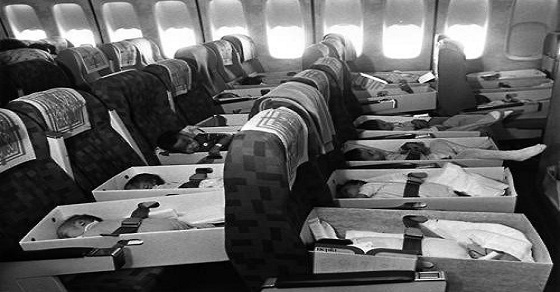











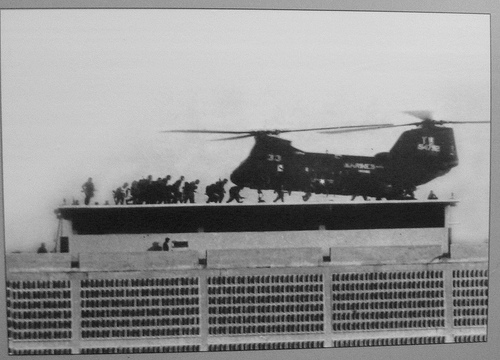
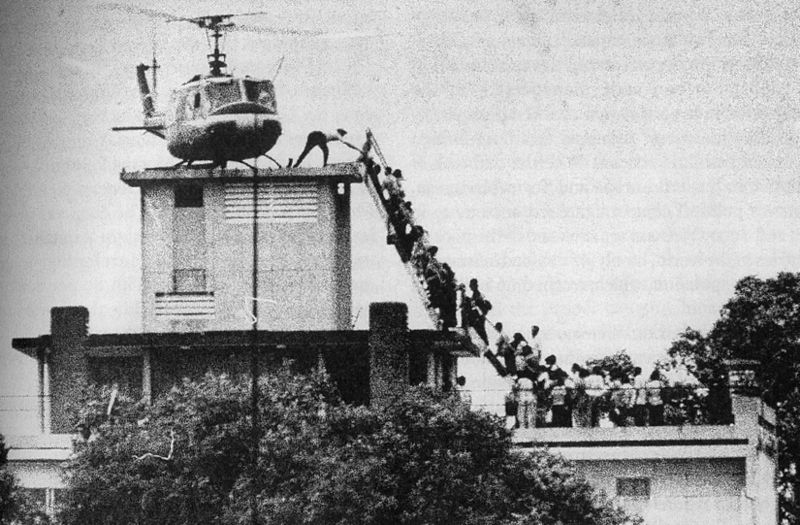








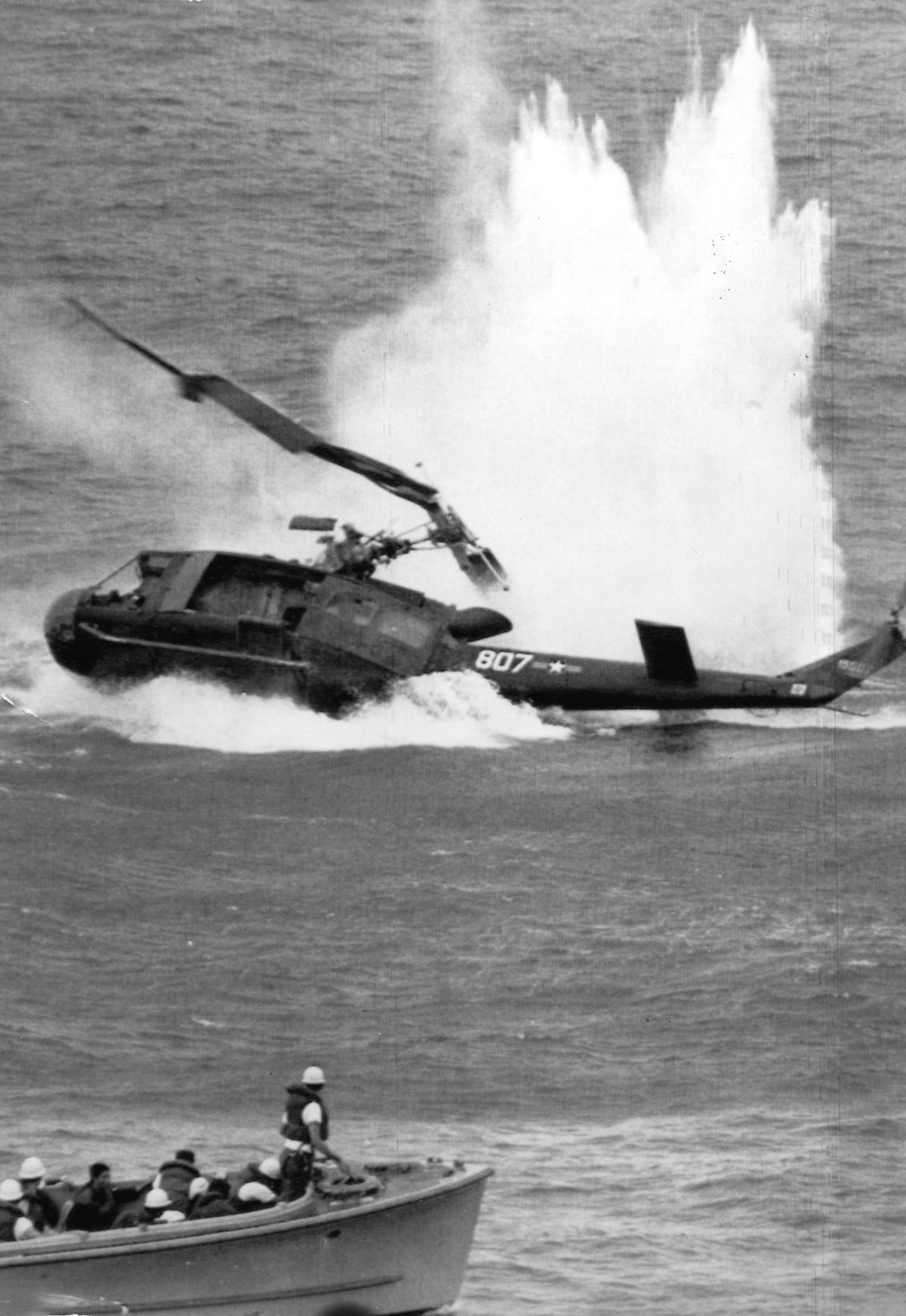


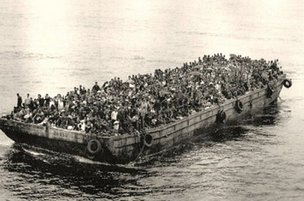
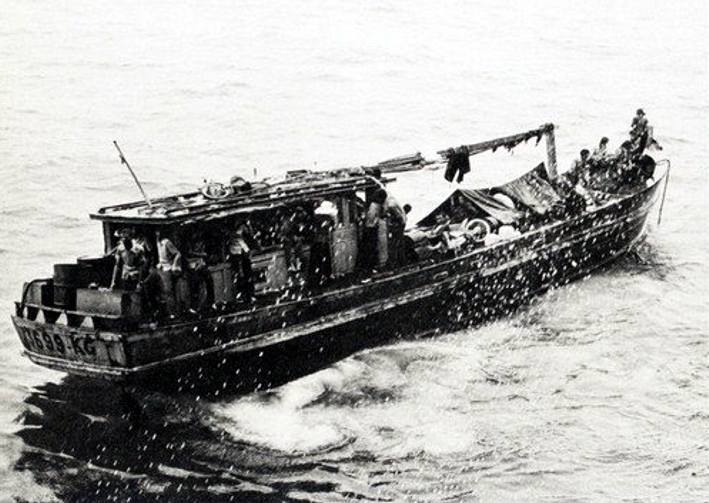


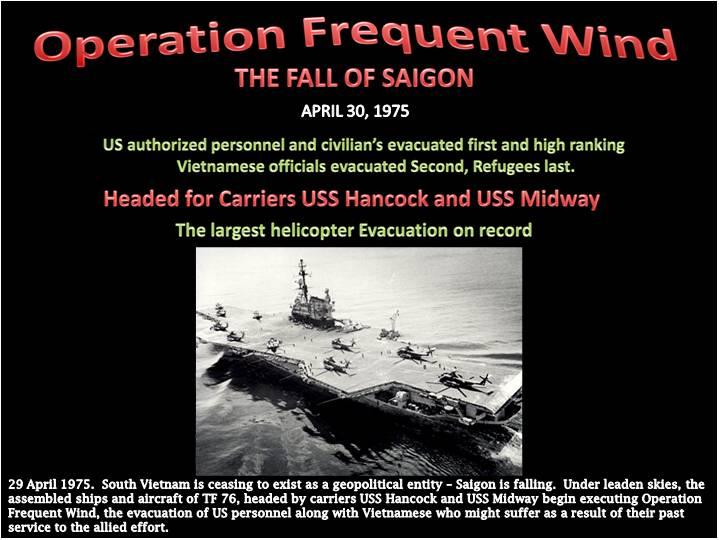

Was present and involved in this operation from the Okinawa as a Marine. Some very vivid memories of loading a one legged mother or Grandmother and child onto a chopper. Recall a photographer flew in with us..Slept on the flight after so that the refugees could have our racks..
LikeLiked by 2 people
Was present aboard USS Schofield DEG-3 performing independents ops away from the main force. The end of an era that never had to have occurred. If only the USA had told the French to stay away, to not engage in colonialism after we rescued them from Nazi tyranny, the odds were excellent that Vietnam could have been a friend, perhaps even an ally. Only an educated guess… no way to know since a different path was followed by those “leaders” of the past.
LikeLike
I was stationed at Utapao, RTNB during the evacuation where many Vietnamese pilots landed . Many wanted to return for their families but were not allowed , drugged and flown to the Philippines. Our base commander was replaced for his actions . We wound up with many refugees on our beaches for months before getting them relocated .
LikeLike
Hi John,
Another great piece. Thanks again for all your efforts to inform people of this time in history.
LikeLike
I had a very good friend (old boyfriend), a Navy PH1 John Sheppard, who was there at the end, shooting pix on his way out. He told me he got to the coast and picked up a boat out to one of the carriers – either Hancock or Midway, don’t remember which one – and said it was like being in a herd of stampeding cattle.
Reposting this at This Aint Hell on the Helicopter Pilots Monument thread. http://thisainthell.us/blog/?p=71813
LikeLike
Politics and War, always a bad combination. When we have those without a clue, trying to micro manage war fighting only the politicians win. Marine corporals McMahon and Judge killed at the DAO compound were the last casualties of actual ground combat. There have many who came home and died surly as though an AK-47 round killed them. Then there are those of us who suffer from the effects of Agent Orange and are dying as a result. Of course there are those of us who suffer from PTSD. Our bodies came home but our minds were left in-country. Thanks to Eisenhower, Kennedy & Co, Richard Nixon, The Whiz Kids lead by McNamara and the assoted colection of politicians and generals, PEACEwith HONOR became joke on April 30, 1975. We the ground troops had the war won and the politicians and generals gave it away.
To the Author, an extremely informative and well written article
LikeLike
thanks to LBJ the war ended this way
LikeLike